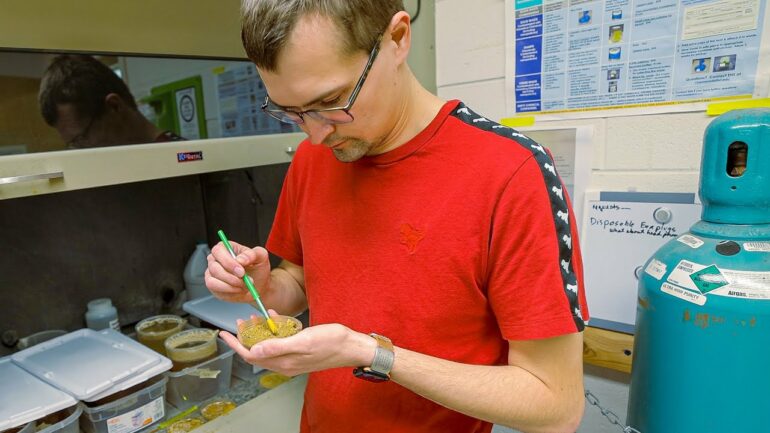Is nitrate responsible for algae, flowers, and even your neighbors? A team of Virginia Tech geoscientists have unearthed evidence that may indicate yes.
The team’s findings, recently published in Science Advances, reveal an increase in biologically available nitrogen during the time that marine eukaryotes—organisms whose cells have a nucleus—became dominate. Complex eukaryotic cells evolved into multicellular organisms and are credited for ushering in a whole new era for life on Earth, including animals, plants, and fungi.
“Where we sit today, with life as it is on the planet, is the sum total of all the events that happened in the past,” said Ben Gill, an associate professor of sedimentary geochemistry and co-author on the paper. “And this is a key event where we shift from dominantly prokaryotic ecosystems—cells that are much simpler than the ones in our bodies—to eukaryotes. If that did not happen, we would not be here today.”
Previous research focused on phosphorus’ role in the rise of eukaryotes, but Junyao Kang, a doctoral student in the Department of Geosciences and lead author of the paper, was curious about the part nitrogen played in this event.
“This data is unique because nitrogen isotope data are virtually nonexistent from the early Neoproterozoic time period, or between a billion and 800 million years ago,” said Kang.
Collaborating with the Nanjing University in Najing, China, Kang has spent two years working to understand what drove the rise of eukaryotes through nitrogen isotope analysis of rock samples from the North China Craton. Home to rocks dating back 3.8 billion years ago, the region was once covered by an ocean.
“We had some rough ideas of when eukaryotes became ecologically successful,” said Shuhai Xiao, professor of geobiology and a paper co-author. “They had been there for a long time in a low-key status until about 820 million years ago, when they became abundant.”
Kang decided he wanted to learn why. He took the data from the rock samples, entered it into a larger database, and analyzed it across a longer time scale that spanned different geographic locations.
“Once we did this kind of integration and put it into a big picture, we saw the rise of nitrates through time, which happened around 800 million years ago,” said Kang.
Solid collaboration
A collaborative, international approach was key to connecting this new data with biological events, mostly notably, the rise of eukaryotes.
Gill and Rachel Reid, also a College of Science geochemist and co-author of the paper, provided critical analyses through resources, including the mass spectrometer in the Geoscience Stable Isotope Lab at Virginia Tech. An elemental analyzer coupled to the mass spectrometer allowed the researchers to extract pure nitrogen gas from the samples for analysis.
Gill specializes in reconstructing present and past chemical cycles on our planet. He collaborates with paleontologists to study the record of life preserved in the geological record and examines what potential environmental drivers might have enabled changes in life through history.
Reid, who generally focuses her research on Earth’s more recent events, had a special opportunity to offer her nitrogen isotope expertise to these ancient fossils.
Feifei Zhang, a geochemist at Nanjing University, was the paper’s fourth co-author. Zhang provided insights on how much oxygen would have been available in the oceans during the time when nitrate increased in abundance.
All of the Virginia Tech authors are affiliated members of the Fralin Life Sciences Institute’s Global Change Center, with Kang serving as a Ph.D. fellow in the Interfaces of Global Change graduate program. The center brings together experts from diverse disciplines to solve these complex global challenges and train the next generation of leaders.
Past, present, and future
Xiao, who has helped excavate and study some of the most ancient fossils from around the world, said this type of study gives him hope for future discoveries. The team members look forward to collaborating with NASA on future grants, such as the exobiology program supporting their current research.
He also credits University Libraries at Virginia Tech for its support of open-access publications, such as Science Advances, to provide a vetted selection of research, freely available to readers.
“We can link the dots from the nitrogen isotopic compositions in the ancient past and then go to the next step and infer how much nitrate was available for organisms,” said Xiao. “And then we tie that with the fossil data to show that there’s a relationship.”
While ancient oceans are long gone, what happened in ancient oceans are recorded in rocks, and studying these rocks provides a link from our Earth’s history to the present and to the future.
“Geologists look at rocks for the same reason that stock traders look at the Dow Jones curve when they make decisions to sell or buy stocks. The geological history written in rocks gives us important context about global changes in the future,” said Xiao.
More information:
Junyao Kang et al, Nitrate limitation in early Neoproterozoic oceans delayed the ecological rise of eukaryotes, Science Advances (2023). DOI: 10.1126/sciadv.ade9647. www.science.org/doi/10.1126/sciadv.ade9647
Citation:
Geoscientists shed a light on life’s evolution 800 million years ago (2023, March 22)
